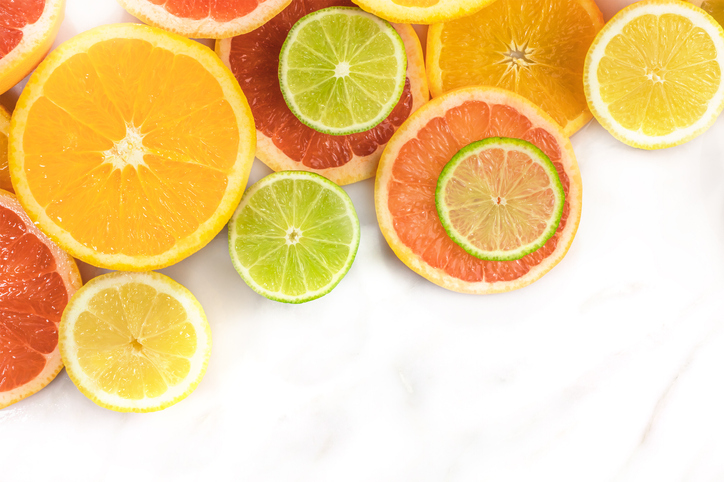
Acids are often thought of as highly destructive chemicals that cause corrosion, but they can also be found in everyday life where they perform incredibly useful functions such as unblocking drains, powering the batteries in our cars, aiding digestion in our stomachs and even adding zest to our food.
Acids are substances that give off hydrogen ions (H+) when dissolved in water. A solution is considered to be acidic when the concentration of hydrogen ions present is greater than it would be for pure water alone. Acidity is measured on the pH scale. Acids all have pH-values of less than 7. The lower the pH-value, the stronger the acid.
Acids have a characteristic sharp, sour taste, although it is best not to taste a substance in order to determine its acidity. A simpler and much safer way to test for the presence of an acid is to use blue litmus paper. This paper turns red when dipped into an acidic solution.
According to chef Samin Nosrat, there are four elements to good cooking: salt, fat, acid and heat. It may seem a bit strange at first that acids are considered important in food, but when you look closely, you’ll see that a number of acids regularly pop up in our kitchens.
In this article we’ll take a closer look at four acids we use almost daily without paying them much attention. We’ll discover their chemical formulas, examine the kinds of foods they’re found in and learn what they’re used for in the kitchen.
Ascorbic acid is also known as vitamin C. It is an essential component of a healthy diet. Humans cannot produce or store vitamin C and must obtain it from outside sources. Vitamin C is important for many functions including wound healing, preventing infections, aiding in the absorption of iron and promoting healthy skin, bones and connective tissue. Most of us know it is found in oranges and orange juice, but it is also found in many other fruits and berries including strawberries, blackberries and tomatoes. Vegetables such as broccoli, potatoes, spinach and even Brussel sprouts also contain vitamin C. A vitamin C deficiency can lead to scurvy, a disease that famously occurred among sailors and people travelling long distances by sea as they did not have much access to fresh fruit and vegetables between ports.
Less commonly known as ethanoic acid, acetic acid is the primary ingredient in vinegar. This colourless acid has a pungent sour smell. There are many different types of vinegars, including apple cider vinegar, red and white wine vinegar, balsamic vinegar, malt vinegar, and rice vinegar. Different types of vinegars have varying acetic acid concentrations. For example, apple cider vinegar contains 5%–6% acetic acid, while the EU standard set for wine vinegars is 6%. Table vinegar which is used to season food, is usually a relatively weak solution consisting of 4%–8% acetic acid, whereas, in vinegar used for pickling, the percentage of acetic acid may be as high as 12%.

Lactic acid is found in the body as a by-product of anaerobic respiration (part of the process cells use to generate energy). Lactic acid build-up in the muscles is well-known for being the cause of pain after over-exercising. Lactic acid is also found in many food products. It is produced by specialised bacteria that digest the lactose in milk and is used in various fermented dairy foods including kefir, yoghurt, buttermilk and sour cream. Other fermented foods such as sauerkraut and pickles also contain lactic acid. Lactic acid-forming bacteria are also found in sourdough bread—giving it that delicious tangy taste. The acid is used to help balance the sweetness in fruit juice and as a mild preservative in bottled salad dressings.
Citric acid is a naturally occurring acid found in citrus fruit. It is most highly concentrated in lemons and limes (their juice contains 1.44 g/oz and 1.38 g/oz, respectively). Citric acid is also found in other citrus fruits such as oranges, kumquats, mandarins and grapefruit. The acid is a natural preservative and is used as a flavouring in foods and drinks including tinned fruits, ice-cream, sorbet, soft drink and wine.

Citric acid is found in a range of citrus fruits, including kumquats, lemons, limes and oranges.
Although the acids mentioned here are safe and edible particularly in measured quantities, some acids are highly corrosive and can cause severe injury and even death. Such acids need to be correctly handled, labelled, tracked and stored.
If you have any questions about the safe storing and handling of acids, or if you need any assistance with SDS or labels for large quantities of acids (or any other chemicals), call Chemwatch on (03) 9573 3100. Our friendly and experienced staff draws on years of experience to offer the latest industry advice on how to stay safe and comply with Health and Safety regulations.
Sources: